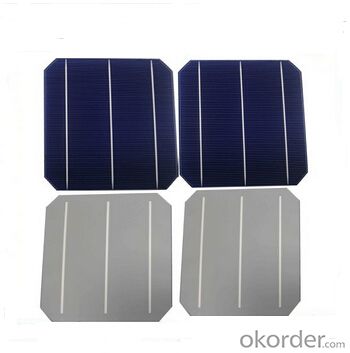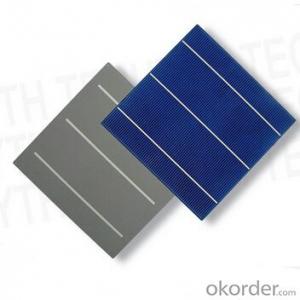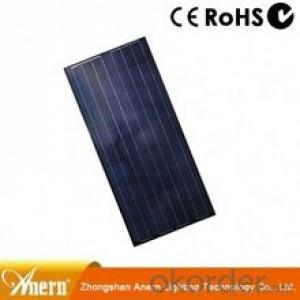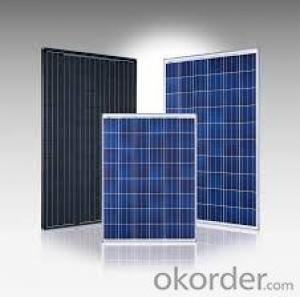Monocrystalline Solar Cells High Quality 17.00-18.20
- Loading Port:
- Shanghai
- Payment Terms:
- TT OR LC
- Min Order Qty:
- 1000 pc
- Supply Capability:
- 1000000 pc/month
OKorder Service Pledge
OKorder Financial Service
You Might Also Like
Solar Cells:
Solar cells is made by solar wafer, it has three categories of solar cell right now, monocrystalline polycrystalline and thin film,These cells are entirely based around the concept PN junction, which is the critical part of solar module, it is the part that can convert the light energy into electricity, the thickness is from 180um to 200um, with even busbars to conduct electricity, textured cell can decrease diffuse reflection; they are often electrically connected and encapsulated as a module. Photovoltaic modules often have a sheet of glass on the front (sun up) side, allowing light to pass while protecting semiconductor wafers from abrasion and impact due to wind-driven debris, rain, hail, etc. Solar cells are also usually connected in series in modules, creating an additive voltage. Connecting cells in parallel will yield a higher current;With high quality and stable quality. Our Cells can greatly improve the performance of Solar Modules.
Features:
1. High conversion efficiencies resulting in superior power output performance.
2. Outstanding power output even in low light or high temperature conditions
3. Optimized design for ease of soldering and lamination
4. Long-term stability, reliability and performance
5. Low breakage rate
6. Color uniformity
Solar Cells Advantage:
• High efficiency and stable performance in photovoltaic conversion.
• Advanced diffusion technique ensuring the homogeneity of energy conversion efficiency of the cell.
• Advanced PECVD film forming, providing a dark blue silicon nitride anti-reflection film of homogenous color and attractive appearance.
• High quality metal paste for back surface and electrode, ensuring good conductivity, high pulling strength and ease of soldering.
• High precision patterning using screen printing, ensuring accurate busbar location for ease with automatic soldering a laser cutting.
Specifications:
Efficiency code | 182 | 180 | 178 | 176 | 174 | 172 | 170 | |
Efficiency | Eff(%) | 18.20 | 18.00 | 17.80 | 17.60 | 17.40 | 17.20 | 17.00 |
Power | Ppm(W) | 4.43 | 4.38 | 4.33 | 4.28 | 4.23 | 4.19 | 4.14 |
Max. Power current | Ipm(A) | 8.26 | 8.22 | 8.17 | 8.12 | 8.08 | 8.05 | 7.99 |
Short Circut Current | Isc(A) | 8.71 | 8.68 | 8.63 | 8.60 | 8.56 | 8.53 | 8.49 |
Max. Power Voltage | Vpm(V) | 0.536 | 0.533 | 0.530 | 0.527 | 0.524 | 0.521 | 0.518 |
Open Cirtuit Voltage | Voc(V) | 0.634 | 0.632 | 0.630 | 0.627 | 0.625 | 0.622 | 0.620 |
Packaging & Delivery of Solar Cells
Carton Box Package and Deliver by air. It should be noticed that it should be avoid of water, sunshine and moist.

FAQ
We have organized several common questions for our clients,may help you sincerely:
①What price for each watt?
It depends on the efficiency of the solar cell, quantity, delivery date and payment terms.
②How long can we receive the product after purchase?
In the purchase of product within three working days, We will arrange the factory delivery as soon as possible. The pecific time of receiving is related to the state and position of customers.Commonly 7 to 10 working days can be served.
③Can you provide the peripheral products of the solar panels, such as the battery, controller, and inverter? If so, can you tell me how do they match each other?
Yes, we can, we have two companies for solar region, one is CNBM International, the other is CNBM engineering Co.
We can provide you not only the solar module but also the off grid solar system, we can also provide you service with on grid plant.
④What is your warranty of solar cell?
Our product can promise lower than 0.3% open box crack, we support claim after opening the box if it has crackm color difference or sth, the buyer should give pictures immediately, we can not accept the claim after the solar cell has assembled to solar panel.
• Timeliness of delivery
• ⑤How do you pack your products?
We have rich experience on how to pack the solar cell to make sure the safety on shipment, we could use wooden box or pallet as buyer's preference.
- Q:How are solar cells used in agricultural applications?
- Solar cells are used in agricultural applications to generate electricity for various purposes, such as powering irrigation systems, lighting in greenhouses, and running equipment like pumps and fans. They help farmers reduce their reliance on traditional energy sources and promote sustainable farming practices.
- Q:What is a multi-junction solar cell?
- A multi-junction solar cell is a type of photovoltaic cell that consists of multiple layers of different semiconductor materials, each designed to absorb different wavelengths of sunlight. This allows the cell to convert a broader spectrum of light into electricity, resulting in higher efficiency and improved performance compared to traditional single-junction solar cells.
- Q:Can solar cells be used in theme parks?
- Yes, solar cells can be used in theme parks. Solar cells can be installed in various areas of theme parks to generate renewable energy that can power attractions, lighting, and other facilities. By utilizing solar energy, theme parks can reduce their carbon footprint and promote sustainable practices.
- Q:What is a solar cell?
- A solar cell, also known as a photovoltaic cell, is a device that converts sunlight directly into electricity. It is made up of semiconductor materials that absorb photons from sunlight, creating an electric current. Solar cells are used in solar panels to generate renewable energy for various applications, such as powering homes and businesses.
- Q:Can solar cells be used for lighting?
- Yes, solar cells can be used for lighting. Solar cells generate electricity from sunlight and this electricity can be used to power light bulbs or other lighting devices. This allows for the use of renewable energy sources and can be particularly beneficial in remote areas or during power outages.
- Q:I would like to use a ppt to show how solar cells can work in a power generation factory, can anybody share some useful information with me?
- The solar cell works in a process following scientific research, you'd better refer to some books to make it right.
- Q:How do solar cells perform in areas with high levels of chemical pollutants?
- Solar cells may experience a decrease in performance in areas with high levels of chemical pollutants due to the reduced intensity of sunlight reaching the cells. The presence of pollutants in the atmosphere can block or scatter sunlight, leading to a decrease in the amount of energy absorbed by the solar cells. This can result in a reduction in the efficiency of solar panels and a decrease in their overall power output. Regular cleaning and maintenance of the solar panels can help mitigate the negative impact of chemical pollutants on their performance.
- Q:Are solar cells safe for the environment?
- Yes, solar cells are safe for the environment. They generate electricity using sunlight, which is a clean and renewable energy source. Solar cells do not emit any greenhouse gases or pollutants during operation, making them an environmentally friendly energy solution. Additionally, they have a long lifespan and can be recycled, reducing their overall impact on the environment.
- Q:Can solar cells be used for powering remote research stations?
- Yes, solar cells can be used for powering remote research stations. Solar cells are an effective and sustainable source of renewable energy that can provide electricity in remote locations where access to the power grid is limited or nonexistent. By harnessing sunlight and converting it into electricity, solar cells can provide a reliable power supply for various research equipment and facilities in remote areas. Additionally, advancements in solar technology have made solar cells more efficient and cost-effective, making them an ideal choice for powering remote research stations.
- Q:What is the typical warranty for solar cells?
- The typical warranty for solar cells ranges from 10 to 25 years, depending on the manufacturer and type of solar cell.
1. Manufacturer Overview |
|
|---|---|
| Location | |
| Year Established | |
| Annual Output Value | |
| Main Markets | |
| Company Certifications | |
2. Manufacturer Certificates |
|
|---|---|
| a) Certification Name | |
| Range | |
| Reference | |
| Validity Period | |
3. Manufacturer Capability |
|
|---|---|
| a)Trade Capacity | |
| Nearest Port | |
| Export Percentage | |
| No.of Employees in Trade Department | |
| Language Spoken: | |
| b)Factory Information | |
| Factory Size: | |
| No. of Production Lines | |
| Contract Manufacturing | |
| Product Price Range | |
Send your message to us
Monocrystalline Solar Cells High Quality 17.00-18.20
- Loading Port:
- Shanghai
- Payment Terms:
- TT OR LC
- Min Order Qty:
- 1000 pc
- Supply Capability:
- 1000000 pc/month
OKorder Service Pledge
OKorder Financial Service
Similar products
New products
Hot products
Hot Searches
Related keywords



























